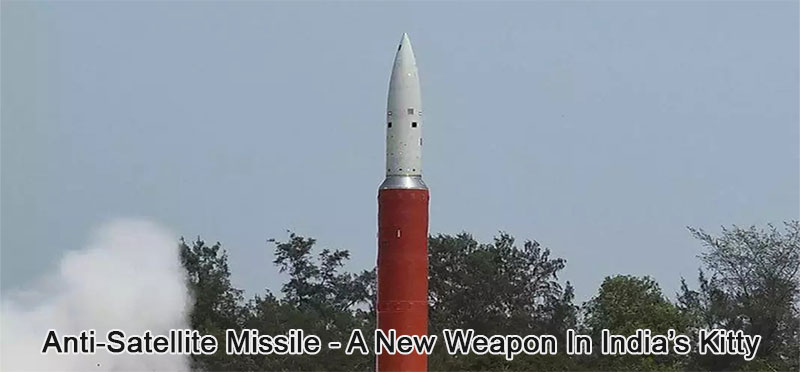
India has successfully test-fired an anti-satellite missile (ASAT) that has the capacity to destroy any satellite flying in the orbit.
Mission Shakthi :-
- Tentatively named Mission Shakti, the test is a technology demonstration of India’s ability to develop and deploy anti-satellite missile technology which only a select few countries possess.
- Other than India, only the USA, Russia and China have missiles that can target and destroy a satellite.
- The mission involved launching of a Ballistic Missile Defence Missile from Abdul Kalam Test range in Odisha, which traveled 300km into the Low Earth Orbit and hit a live satellite within three minutes of the launch.
- The satellite is a functional satellite of India, probably Microsat-R of Defence Research and Development Organisation (DRDO).
- The missile carried no warhead.
- Instead, the technology utilized was ‘kinetic kill’ where the missile’s kinetic force penetrates the satellite and destroys it.
What About Space Debris?
Unlike China’s anti-satellite missile test that hit a satellite in 800km orbit caused thousands of small and major space debris, India chose its target carefully to minimize the impact of the debris.
- As per DRDO, the debris of the satellite will fall back into Earth’s atmosphere and burn up.
- The debris caused by the Chinese test is still floating in the outer atmosphere posing a threat to space assets of all nations.
With careful choice, India demonstrated that it is a responsible nation.
Why Kinetic Kill?
As per scientists from DRDO, the choice of the kinetic kill was simply because India has proven capability in this technology.
The other technologies are fly-by tests and jamming.
What is the Missile Range?
For the test, the choice of distance was 300 km. But, scientists say that with our capabilities, satellites in any orbit where 300km or 800km or more can now be targeted.
Peaceful Test :-
The government has reassured the world nations that the test is a peaceful test and is not intended against any country.
It is done to verify India’s ability to safeguard its space assets.
Also, the Prime Minister of the country has stated that India stick’s to it no first use policy while deploying such weapons.
But, when necessitated, India will not hesitate to use it.
Is Outer Space Being Militarised?
All the nations accorded outer nations to be a global common for humankind.
But, countries like USA, Russia, and China have all made weapons that have militarised the outer space.
With the recent announcement of a space corps by the President of the United States, it seems that the outer space will soon be militarised.
But, India on its part made it clear that the ASAT test was a technology demonstration and it supports Prevention of an Arms Race in Outer Space (PAROS).
What is PAROS :-
- Prevention of an Arms Race in Outer Space (PAROS) is a resolution passed in the UN that advocates ban on the weaponization of outer space.
- This resolution acknowledges that at the Outer Space Treaty of 1967 does not guarantee the prevention of weaponization of outer space.
- The resolution also calls the Conference on Disarmament – the UN forum for disarmament negotiation – to form an ad hoc committee regarding PAROS issues.
Also Read: – All About Rupee-Dollar Swap of RBI
The Outer Space Treaty :-
This is the principal treaty on outer space for which India is a signatory.
The treaty prohibits only weapons of mass destruction in the outer space but not ordinary weapons.
As per the treaty, India did not violate it with the test.
Also Read: – India’s Carbon Emissions On The Rise – International Energy Agency Report
Conclusion :-
- For many years now, India has constantly improved its space capabilities.
- The current ASAT test too should be seen in this light.
- It neither targets any nation nor threatens to do so.
- But, it is time for the world nations to sit together and make crucial decisions on making outer space weapons free.
- Much of the progress made by humanity in outer space will be lost if weaponization is allowed.

Leave a Reply
You must be logged in to post a comment.